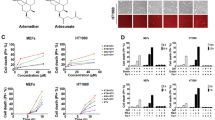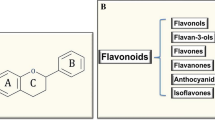Summary
Artemisinin, also termed qinghaosu, is extracted from the traditional Chinese medicine artemesia annua L. (the blue-green herb) in the early 1970s, which has been confirmed for effectively treating malaria. Additionally, emerging data prove that artemisinin exhibits anti-cancer effects against many types of cancers such as leukemia, melanoma, etc. Artemisinin becomes cytotoxic in the presence of ferrous iron. Since iron influx is high in cancer cells, artemisinin and its analogs selectively kill cancer cells with increased intracellular iron concentrations. This study is aimed to investigate the selective inhibitory effects of artemisinin on SMMC-7721 cells in vitro and determine the effect of holotransferrin, which increases the concentration of ferrous iron in cancer cells, combined with artemisinin on the anticancer activity. MTT assay was used for assessing the proliferation of SMMC-7721 cells treated with artemisinin. The induction of apoptosis and inhibition of colony formation in SMMC-7721 cells treated with artemisinin were determined by TdT-mediated dUTP nick end labeling (TUNEL) and colony formation assay, respectively. The results showed that artemisinin at various concentrations significantly inhibited growth, colony formation and cell viability of SMMC-7721 cells (P<0.05), likely due to induction of apoptosis of SMMC-7721 cells. Of interest, it was found that incubation of artemisinin combined with holotransferrin sensitized the growth inhibitory effect of artemisinin on SMMC-7721 cells (P<0.01). Our data suggest that treatment with artemisinin leads to inhibition of viability and proliferation, and apoptosis of SMMC-7721 cells. Furthermore, we observed that holotransferrin significantly enhanced the anti-cancer activity of artemisinin. This study may provide a potential therapeutic choice for liver cancer.
Similar content being viewed by others
References
Badvie S. Hepatocellular carcinoma. Postgrad Med J, 2000,76(891):4–11
He SP, Tan GY, Li G, et al. Development of a sensitive monoclonal antibody-based enzyme-linked immunosorbent assay for the antimalaria active ingredient artemisinin in the Chinese herb Artemisia annua L. Anal Bioanal Chem, 2009,393(4):1297–1303
Sriram D, Rao VS, Chandrasekhara KV, et al. Progress in the research of artemisinin and its analogues as antimalarials: an update. Nat Prod Res, 2004,18(6):503–527
Li PC, Lam E, Roos WP, et al. Artesunate derived from traditional Chinese medicine induces DNA damage and repair. Cancer Res, 2008,68(11):4347–4351
Djimde AA, Fofana B, Sagara I, et al. Efficacy, safety, and selection of molecular markers of drug resistance by two ACTs in Mali. Am J Trop Med Hyg, 2008,78(3): 455–461
Mercer AE, Sarr Sallah M. The pharmacokinetic evaluation of artemisinin drugs for the treatment of malaria in paediatric populations. Expert Opin Drug Metab Toxicol, 2011,7(4):427–439
Efferth T, Kaina B. Toxicity of the antimalarial artemisinin and its dervatives. Crit Rev Toxicol, 2010,40(5): 405–421
Adam I, Elhassan EM, Omer EM, et al. Safety of artemisinins during early pregnancy, assessed in 62 Sudanese women. Ann Trop Med Parasitol, 2009,103(3): 205–210
Smithuis F, Kyaw MK, Phe O, et al. Efficacy and effectiveness of dihydroartemisinin-piperaquine versus artesunate-mefloquine in falciparum malaria: an open-label randomised comparison. Lancet, 2006,367(9528):2075–2085
Bousejra-El Garah F, Wong MH, Amewu RK, et al. Comparison of the reactivity of antimalarial 1,2,4,5-tetraoxanes with 1,2,4-trioxolanes in the presence of ferrous iron salts, heme, and ferrous iron salts/phosphatidylcholine. J Med Chem, 2011,54(19):6443–6455
Anderson KM, Seed T, Ou D, et al. Free radicals and reactive oxygen species in programmed cell death. Med Hypotheses, 1999,52(5):451–463
Deugnier Y, Turlin B. Iron and hepatocellular carcinoma. J Gastroenterol Hepatol, 2001,16(5):491–494
Kim KS, Kim H, Kim NG, et al. Proteomic analysis and molecular characterization of tissue ferritin light chain in hepatocellular carcinoma. Hepatology, 2002,35(6):1459–1466
Lai H, Sasaki T, Singh NP, et al. Effects of artemisinin-tagged holotransferrin on cancer cells. Life Sci, 2005,76(11):1267–1279
Tan WF, Shen F, Luo XJ, et al. Artemisinin inhibits in vitro and in vivo invasion and metastasis of human hepatocellular carcinoma cells. Phytomedicine, 2011,18(2–3): 158–162
Kowdley KV. Iron, hemochromatosis, and hepatocellular carcinoma. Gastroenterology, 2004,127(5 Suppl 1):S79–S86
Chen J, Chloupkova M. Abnormal iron uptake and liver cancer. Cancer Biol Ther, 2009,8(18):1699–1708
Deng XR, Yu HP, Pan L, et al. Artemisinin and holotransferrin induces apoptosis in hepatoma cells. Chin J Exp Surg (Chinese), 2008,25(6):802
Reed JC. Mechanisms of apoptosis. Am J Pathol, 2000,157(5):1415–1430
Hanahan D, Weinberg RA. The hallmarks of cancer. Cell, 2000,100(1):57–70
Evan GI, Vousden KH. Proliferation, cell cycle and apoptosis in cancer. Nature, 2001,411(6835):342–348
Singh NP, Lai HC. Artemisinin induces apoptosis in human cancer cells. Anticancer Res, 2004,24(4):2277–2280
Author information
Authors and Affiliations
Corresponding authors
Additional information
These authors contributed equally to this work.
Rights and permissions
About this article
Cite this article
Deng, Xr., Liu, Zx., Liu, F. et al. Holotransferrin enhances selective anticancer activity of artemisinin against human hepatocellular carcinoma cells. J. Huazhong Univ. Sci. Technol. [Med. Sci.] 33, 862–865 (2013). https://doi.org/10.1007/s11596-013-1212-x
Received:
Revised:
Published:
Issue Date:
DOI: https://doi.org/10.1007/s11596-013-1212-x




